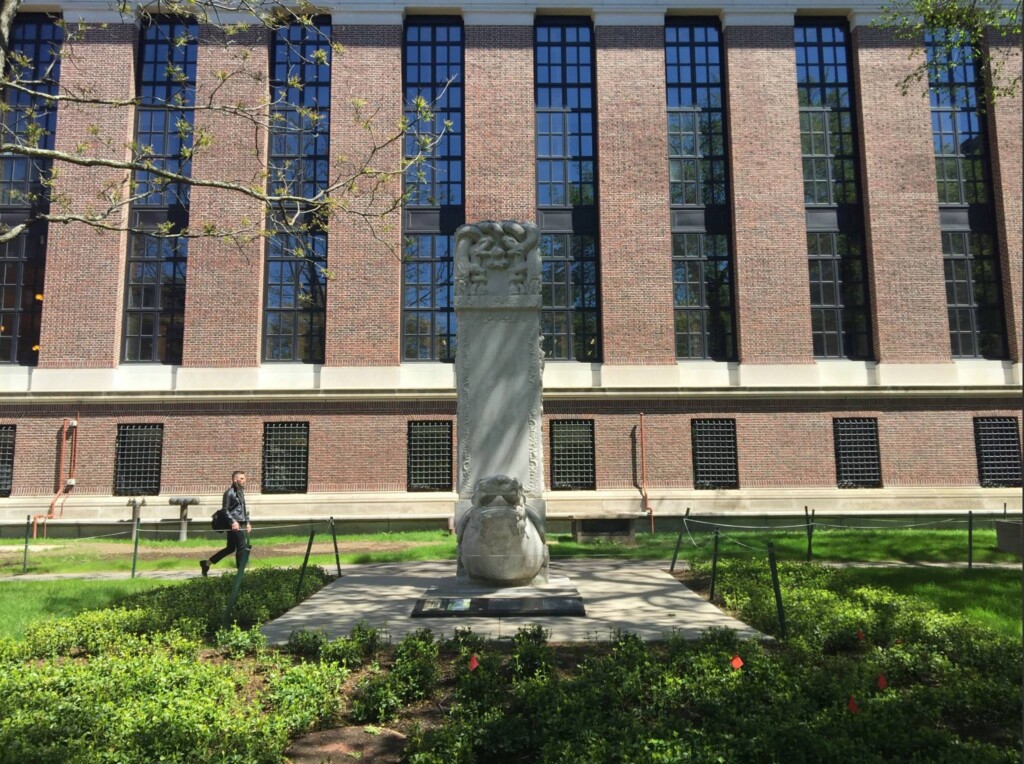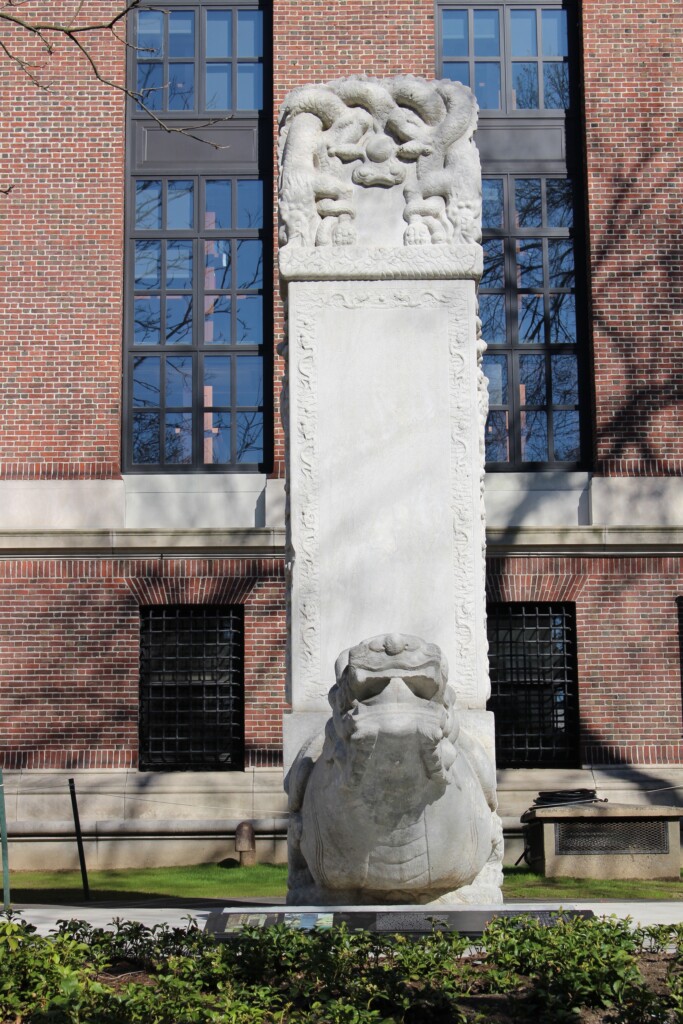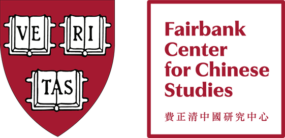
History
This slender marble slab, or stele, was presented to Harvard in 1936 as a gift from Chinese alumni on the occasion of the University’s tercentenary. The inscription commemorates the founding of Harvard College in 1636 and celebrates the importance of culture and learning both in the United States and in China. The full Chinese text, 370 words long, is presented on the accompanying panel, together with an English translation; the original calligraphy, in kaishu 楷书 style, is that of the famous scholar-diplomat Hu Shi 胡適 (1891-1962), who took part in the ceremonies as the representative of Peking University and received an honorary degree.
The photograph shows the stele’s appearance shortly after it was erected on this site, just to the west of Widener Library and close to Boylston Hall, the imposing granite building on your right as you face the stele. This was the first home of the Harvard-Yenching Institute, established in 1928, and the Department of Far Eastern Languages and Civilizations, formed in 1937. Both the Institute and the Department (now the Department of East Asian Languages and Civilizations) moved to their present location at 2 Divinity Avenue in 1957, but the stele – which, together with its elaborately carved tortoise base, weighs some twenty tons – remains in the Yard, testimony to the University’s enduring commitment to international education and its long engagement with the study of the wider world.
The erection of stone monuments to memorialize important events or individuals has a very long history in China, dating back over two millennia. Many are mounted on the back of just this sort of creature, called a bixi 赑屃 in Chinese. This particular stone served first to honor a prominent official during the Qing dynasty, Song-yun 松筠 (1752-1835). In 1810, when he had just been named to serve as governor-general of the two provinces of Jiangsu and Jiangxi, the Jiaqing emperor 嘉慶 (r. 1796-1820) ordered the stone placed in the courtyard of the governor-general’s offices in the city of Nanjing. The original inscription praised Song-yun for his honesty and dedicated service to the empire. That inscription is preserved in local histories, but is gone from the stele itself, replaced by the inscription you now see.
How the stele moved from Nanjing to Cambridge is an interesting story. The gift was the brainchild of Fred Sze ’18, a prominent banker and president of the Harvard Club of Shanghai in the 1930s. With advance knowledge of the ceremonies to be held to celebrate Harvard’s 300th anniversary, Sze approached Dr. Liu Ruiheng ’09, MD ’13, president of the Harvard Club of Nanking (Nanjing). Liu was one of Harvard’s most distinguished Chinese alumni. Among the first Chinese to graduate from the College, and also the first Chinese graduate of the Harvard Medical School, he directed the Peking Union Medical College for many years, where he performed operations on such prominent figures as Sun Yatsen 孫中山 and Liang Qichao 梁啟超. Liu was also the founder of China’s first modern public health system.
The two men went to the President of the Republic of China, Chiang Kai-shek 蔣中正, with their idea to repurpose the stele for a gift to their alma mater. As the old governor-general’s offices then served as the presidential palace, it was necessary to obtain Chiang’s permission. Over one thousand Chinese alumni contributed funds for the purchase, carving, and transportation of the stele, which arrived in Harvard Yard in time for the Tercentenary in fall 1936, when Sze and Liu together formally presented it to the University as the representative of Chinese alumni at the ceremonies.
After several decades, the inscription on the stele has faded in many places, and the stone has suffered from acid rain. To protect it from further degradation, the University wraps the monument in a sturdy cover during the winter months. In 2012, the Peabody Museum of Anthropology and Ethnography completed a 3D digital scan of the stele.
300th Anniversary Stele Inscription
Culture is the lifeblood of a nation. It is by virtue of its culture that a nation arises, but truly it is due to learning that a culture flourishes. Intellectuals with deep knowledge and far-sighted vision understand that in establishing a solid foundation for their nation, the utmost priority must be given to the enhancement of learning. In the beginning, learning is an arduous undertaking, yet once it has grown and expanded, it can contribute to the enhancement of culture for centuries. That this is indeed the case is amply confirmed by the example of Harvard University in the United States of America.
Three hundred years ago, Mr. John Harvard left England for America to teach in Boston. The college that was established in Cambridge was later named after him. Resplendent in its conception and with a full array of subjects of study, the university fostered generations of talented individuals and thus became a world-renowned center of learning. Its glorious history even rivals that of the United States. Mr. Harvard’s contribution of deep knowledge and far-sighted vision to the nation’s culture is truly great.
Our nation symbolizes an ancient culture of the East, but time irrevocably moves forward and the world evolves, constantly undergoing renewal and change. Those committed to learning once again have studied overseas to deepen their knowledge and self-understanding. During the past thirty years, nearly one thousand of our countrymen have returned home upon completion of their studies at Harvard University to serve the nation and society. This is truly marvelous!
On this, the occasion of the tercentenary of the founding of our alma mater, we show our gratitude for the nurturing and inspiration we received here. Henceforth, we hope to witness the further enlargement and expansion of an ever-increasing cultural interchange between our two countries, enabling the prosperity of the nation to follow the path of advanced learning. Of this ideal we shall remain ever mindful.
Erected respectfully by all the Chinese alumni of Harvard University, September 1936
Original translation by Ruiheng Liu 1909, MD 1913
Revised translation by Weiming Tu and Mark Elliott
哈佛三百周年石碑
美國哈佛大學三百年紀念記
文化為國家之命脈。國家之所以興也繇於文化。而文化之所以盛也實繇於學。深識遠//見之士。知立國之本必亟以興學為先。創始也艱自是光大而擴充之。而其文化之宏。往//往收效於數百年間。而勿替是說也徵之於美國哈佛大學滋益信矣。哈佛約翰先生於//三百年前由英之美講學於波士頓市。嗣在劍橋建設大學即以哈佛名之。規制崇閎學//科美備因而人才輩出為世界有名之學府。與美國之國運爭榮。哈佛先生之深識遠見//其有造於國家之文化也大矣。我國為東方文化古國。然世運推移日新月異。志學之士//復負笈海外以求深造。近三十年來就學於哈佛大學學成歸國服務於國家社會者先//後幾達千人。可云極盛。今届母校成立三百年紀念之期。同人等感念沾溉啟迪之功。不//能無所表獻。自茲以往當見兩國文化愈益溝通必更光大擴充之使國家之興盛得随//學問之進境以增隆。斯則同人等之所馨香以祝。而永永紀念不忘者爾//
西曆一九三六年九月哈佛大學中國留學生全體同人敬立

